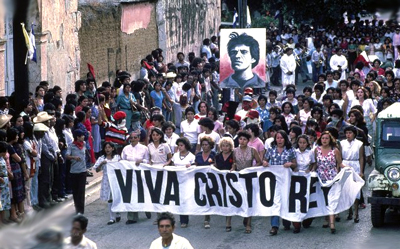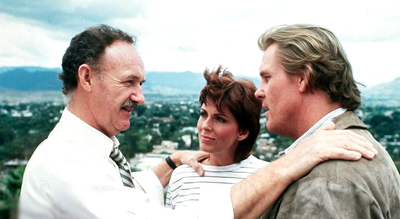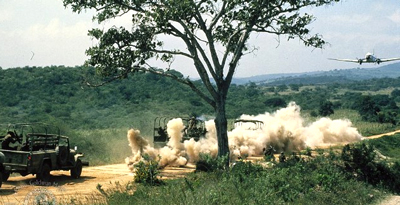
 |
|
|
|
Movies about controversial foreign policies don't have it easy. Make the heroes too interesting and a director will be accused of trivializing life & death issues. Engage with the subject matter and your movie will be flagged as partisan propaganda or an official whitewash. Roger Spottiswoode's 'political adventure thriller' Under Fire chooses a tough row to hoe: it wants to be a righteous box-office winner yet not turn off the ticket buying public by being too political. 
Back in the 1930s and '40s the men in charge of the Production Code used their powers to pre-censor and politically neutralize the rare liberal film with a political agenda. The leftist pictures Blockade and For Whom the Bell Tolls are documented examples. The 1980s saw a flurry of impassioned movies about the world's political trouble spots -- Indonesia, South Africa, Central America. But they invariably centered on the problems of attractive white people played by movie stars, on the principle that Americans "need somebody to care about". Thus Peter Weir's The Year of Living Dangerously follows Mel Gibson as he tries to report the truth during a crackdown by an Indonesian dictator; all we learn about the locals is that they're poor and oppressed. I recall post-screening conversations that focused on the amazing Linda Hunt, who passed as a convincing Indonesian. Richard Attenborough's Cry Freedom doesn't tell us much about the South African apartheid martyr Stephen Biko, preferring to follow Kevin Kline's character, a white who gets in trouble for writing about Biko. 1 The subject of Under Fire is 1979 Nicaragua, where we see some very big stars pull down big dramatic scenes, while covering somebody else's civil war. They're daring and glamorous. Contemporary reviewers as well as the disc-spinners at Twilight Time compare Under Fire to Casablanca, another romance set amid political intrigue. As far as Hollywood goes, the problems of three crazy people do indeed amount to more than a hill of beans in this crazy world. The show follows the daring exploits of frontline journalists. African rebels win their civil war, so news photographer Russell Price (Nick Nolte), top correspondent Alex Grazier (Gene Hackman) and ace reporter Claire (Joanna Cassidy) depart to their next hot spot assignment in Central America. Nicaragua's ridiculously corrupt dictator Anastasio Somoza (René Enríquez) is losing his country to the Sandinista rebellion, and President Carter has halted arms aid because the rebels are getting the upper hand. Alex goes back to New York to become a TV anchor, leaving Russell to take his place as Claire's lover. The pair works hard to contact the elusive rebel leader Rafael (Jorge Zepeda), who has never had his picture taken. French intelligence operative Marcel Jazy (Jean-Louis Trintignant) is friendly and accommodating, even though he works for Somoza. Unlike the press corps that sticks close to Managua, Russell and Claire venture to the towns where the fighting is happening, risking their lives for an interview. Russell comes in contact with the hired mercenary Oates (Ed Harris), who delights in his assignment to find and murder Sandinista leaders. Our couple finds the rebels to be brave and committed patriots, clearly deserving of help. But will the journalists take sides? 
Given its subject matter Under Fire is a decent enough movie about what was happening in Nicaragua in 1979, even though by 1983, the Sandinistas our heroes so heartily support had officially become enemies of America's interests. Viewers with close knowledge of the conflict might see the film as Hollywood's way of turning a profit from war and suffering, even though it attempts in its way to educate viewers beyond the version being told on the 6 O'clock news. By contrast, 1982's Missing comes right out and accuses the U.S. of collusion in the fascist coup in Chile. Its maker Costa-Gavras was a foreign filmmaker already considered a radical. That Universal could release such a film is an endorsement of the freedoms in our American system. But the grim Missing is not a romantic adventure thriller. The wife doesn't find her husband and no movie star replaces him. Its contrary politics sideline it as radical propaganda, to be booked in University towns. Under Fire is tense, exciting and reasonably believable. Our openhearted Yankee journalists risk their lives to uncover the truth -- but then break the rules of their profession and fake some photos for 'humanitarian' reasons. It's pretty amusing when Alex, now their boss, finds them out. Claire and Russell hem and haw and have no excuses for what they did; it's tied into their new romance. Under Fire does not paint bleeding hearts in a very favorable light. 2 
Volker Schlöndorff's Circle of Deceit (1981) dispenses with Under Fire's moral dilemma with one brief, brutally instructive scene. A sniper offers to help a journalist covering Beirut (Bruno Ganz) by shooting a man for him, so he can get a big picture. The journalist is naturally taken aback, but the film doesn't condemn the sniper. It's war and random atrocities are the norm. When everybody's doing it, it's pointless to demonize vermin like Ed Harris's Oates. Ganz decides that ultimate responsibility lies with his editors back in Germany, who want to sell magazines with gory war photos. Under Fire blames everybody but the folks back home: a degenerate soldier of fortune, a nasty dictator, a treacherous French spy. This politically tilted movie plays best as escapist entertainment. Nick Nolte is dashing and resolute as he clicks away with his cameras and risks being shot down by strafing airplanes and government soldiers. Nolte is granted most of the film's entertainingly snappy dialogue, with Gene Hackman second in line. The greatest sin of Hackman's Alex seems to be his prioritizing his career above his interest in Claire. Russell would seem to 'inherit' Claire because they share a preference for fieldwork. Two days in hostile territory and they decide that they're now an item. Joanna Cassidy brings a refreshing maturity to Claire. I rather like the way that she dresses more socially for Somoza, hoping to charm the slimy bastard into giving her a better interview. Jean-Paul Trintignant's slick Frenchman provides an enemy on which to project our contempt. He's so deep in cahoots with Somoza that they even share a girlfriend between them. Ed Harris succeeds wildly in making his mercenary into a functioning psycho, effectively balancing our vision of him as 'clean Marine' Astronaut John Glenn. But the effect is that we see a rotten individual at work, not a rotten U.S. policy. The most visible American on the scene is Richard Masur's solicitous press agent, who tries to convince reporters that, you know, the dictator/thief/murderer Somoza has a point of view too! 
Technically the film is tops. Cameraman John Alcott makes all the lighting seem very natural, without enforcing a phony 'gritty' look: I would imagine that warfare in Central America would indeed take place in beautiful light, under glorious skies. The combat action in the narrow streets is entirely convincing. Although the production had few (maybe just one?) small tanks to work with, they seem to be everywhere. This is a good film from director Roger Spottiswoode, who should have received more credit for his phenomenal job of editing in Straw Dogs. Some of Sam Peckinpah's least promising editing ideas work extremely well in that film. 3 The cutting in Under Fire commendably avoids hyping the violence -- a key execution-murder is filmed as Russell would have recorded it, from far away with a telephoto lens. The only cutting technique that comes off as something of a cliché are the freeze frames that indicate Russell's still camera clicking away. 
I would call Under Fire an efficient and engaging thriller that takes a good shot at its subject. It can't help but glamorize the combat journalists, and it doesn't satisfactorily resolve their collaboration with the Sandinistas. By the time of the film's release everything had changed in Nicaragua, especially our role. Unless one was in the political minority that supported the Sandinistas, our heroes must have seemed to be helping the wrong side. 4 The Twilight Time Blu-ray of Under Fire is an attractive HD encoding of a film most often labeled as 'an adventure thriller'. The transfer work by Deluxe Digital is very good. Soundtrack fans will be interested in the Isolated Score Track for Jerry Goldsmith's accomplished music. The stereo audio gets a major discussion workout in the second of two commentaries, while the fascinating first commentary gives us the memories and observations of both director Spottiswoode and a real combat photographer, Matthew Naythons, whose basic career facts are pretty hair-raising. We find out that events in Under Fire were culled from various real experiences. Naythons says that some things he observed were actually transposed from Vietnam. He was indeed working in Managua in 1979, exposed to the same dangers as the characters in the movie. 
It's good to see the bright-faced Joanna Cassidy but her very brief interview featurette contains little more than a greeting and an "I'm glad it's on Blu-ray" comment. A trailer is included. Julie Kirgo's insert flyer essay mixes production notes with political context.
On a scale of Excellent, Good, Fair, and Poor,
Under Fire Blu-ray rates:
Footnotes:
1. There are good exceptions to this pattern, such as The Killing Fields, which allows its reporter's Third World Sidekick to become the leading character for an entire act. American viewers actually identified with the immediate political problems of a non-white person.
2. The writers treat faking an important photo as a 'risk taken in good conscience,' but it's really a much bigger deal. By taking an active role in the conflict they put all of their fellow journalists at risk - in 1979 pro journalists could still demand to be acknowledged as privileged noncombatants. This year's news is filled with grim reports of reporters and camerapersons accused of spying and even executed for political reasons. Nobody knows what to believe, when a newsman (or a student hiker) claims that they are innocent hostages.
3. Director Peckinpah wanted a scene in Major Dundee to intercut action so rapidly that children playing around a Halloween bonfire would be momentarily confused with murderous Apaches beginning a sneak attack. We'll never know if it worked because the scene was dropped from the movie. In Straw Dogs Spottiswoode makes the same concept work by intercutting a rape victim's anxiety watching amateur performances in a social gathering, with a concurrent scene of menace to another young woman outside the hall. It's a successful experiment.
4. Another reason not to go hard on Under Fire -- the movie Broadcast News dramatizes events in the same conflict from the New York end of the news chain. Its 'reporter on the ground' files news film dispatches lauding the brave Contras fighting the horrible Communist regime there. Under Fire's liberal viewpoint was not normal, or even encouraged.

Reviews on the Savant main site have additional credits information and are often updated and annotated with reader input and graphics. T'was Ever Thus.
Review Staff | About DVD Talk | Newsletter Subscribe | Join DVD Talk Forum |
| ||||||||||||||||||